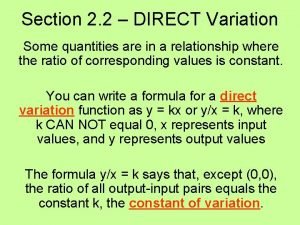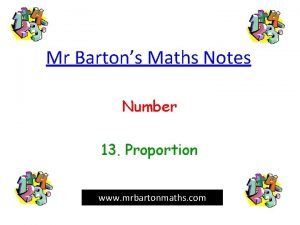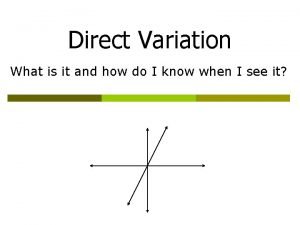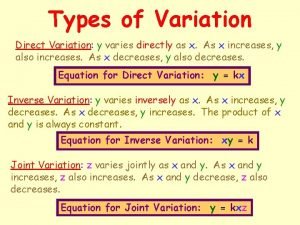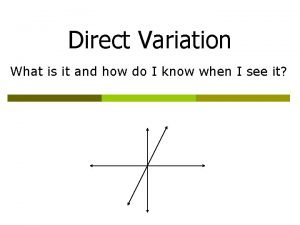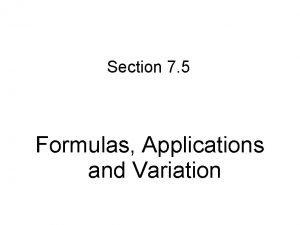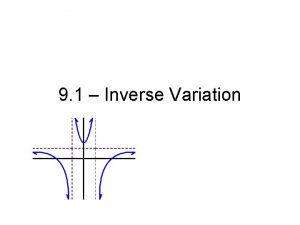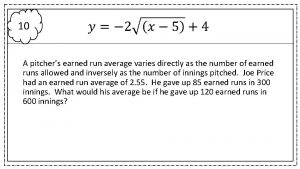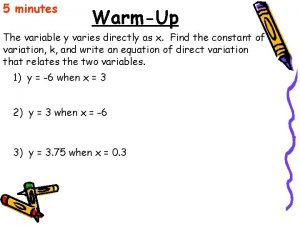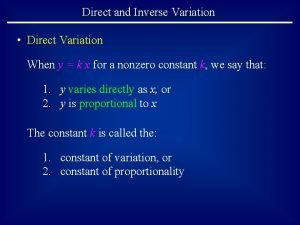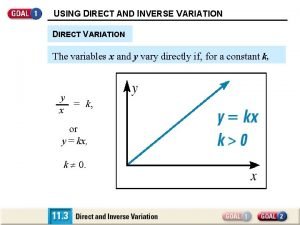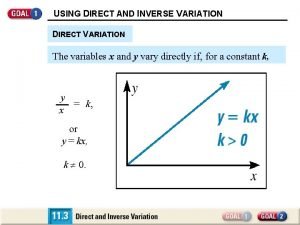DIRECT VARIATION Direct Variation y varies directly as













- Slides: 13

DIRECT VARIATION Direct Variation: y varies directly as x or y is directly proportional to x (y=kx) where k is the constant of proportionality or constant of variation As x gets larger, y gets larger or as x gets smaller, y gets smaller The graph of a direct variation equation is continuous for all values of x and passes through the origin

INVERSE VARIATION Inverse Variation: y varies inversely as x or y is inversely proportional to x (y = (k/x) or xy = k) where k is the constant of proportionality or constant of variation As x gets larger, y gets smaller or as x gets smaller, y gets larger The graph of an inverse variation equation is NOT continuous for all x-values and does not have a y-intercept

EXAMPLES OF DIRECT VARIATION Real world examples of direct variation include: Fruit sold by the pound Distance traveled by a car over time Characters printed from a computer per second Circumference of a circle varies directly as the diameter Wages varying directly to hours worked Hours worked and paid Distance and time Itunes (amount of songs purchased and total amount spent) Length of sides of a figure and perimeter of the figure

EXAMPLES OF INVERSE VARIATION Real world examples of inverse variation includes: Trip to myrtle beach, the greater your car speed the less time it would take you to get there If a rectangle has an area of 15 square units, then as the length increases the width decreases Time it takes for ice to melt varies inversely with the temperature Number of people eating pizza and number of pieces of pizza available person

EXAMPLES Example 1: If y varies directly as x and s=10 when y=9, then what is y when x=4?

EXAMPLES When a bicycle is pedaled in a certain gear, it travels 16 meters for every 3 pedal revolutions. How many revolutions would be needed to travel 600 meter? Use d=kr

EXAMPLE If y varies inversely as x and x=3 and y=9, then what is x when y=27?

EXAMPLE If y varies inversely as the square of x and y=20 when x=4, find y when x=5.

GRAPH CHARACTERISTICS Define by using your phone: • Discrete: • Continuous: • Discontinuous: • Increasing: • Decreasing: • Constant:

ACTUAL DEFINITIONS • Discrete: Data that can only take certain values • Ex: the number of students in a class (you cannot have half a student) • Not continuous data • Continuous: A function is continuous when its graph is unbroken • You can draw the function without lifting your pencil • Discontinuous: a graph that has a form of discontinuity • Types of discontinuity: holes, jump, asymptotes

DEFINITIONS CONTINUED… • Increasing: when the y-value increases as the x-value increases • Tends to go up • Decreasing: y-value decreases as the x-value decreases • Tends to go down • Constant: is a horizontal line • F(x)=k

QUIZ • Piecewise functions • Graphing • Evaluating f(x) • Domain • Range • Increasing and decreasing • Practice: pg 37 -38 #1 -4 • Solving absolute value equations and inequalities • Inverses • Graphing • Graph absolute values and create a piecewise from that • Direct and Inverse Variation • Compositions • Go over: • A f(x) takes a value of x and applies the following: • Step 1) divide x by 3 • Step 2) subtract 7 from the result in Step 1 • Now what steps would be need to describe the inverse function • Step 1) multiply x by 3 • Step 2) add 7 from the result in Step 1

 Determine whether y varies directly with x
Determine whether y varies directly with x Direct variation equation
Direct variation equation Y varies directly as x graph
Y varies directly as x graph The mass of rectangular sheet of wood varies jointly as
The mass of rectangular sheet of wood varies jointly as Problem solving variation
Problem solving variation Varies directly
Varies directly Types of direct variation
Types of direct variation Y varies directly as x
Y varies directly as x What is a constant variation
What is a constant variation Varies directly formula
Varies directly formula The incisal guidance angle varies directly with.
The incisal guidance angle varies directly with. Constant of variation
Constant of variation Inverse eq
Inverse eq Prediction interval formula
Prediction interval formula
